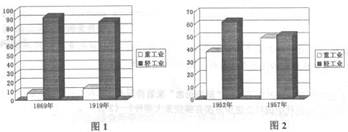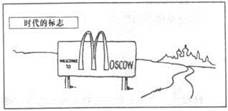阅读下列材料:(25分)
材料一中国一向是世界上最富的国家,就是说,土地最肥沃,耕作最精细,人民最多而且最勤勉的国家。然而,许久以来,它似乎就停滞于静止状态了。今日旅行家关于中国耕作、勤劳及人口稠密状况的报告,与500年前视察该国的马可•波罗的记述比较,几乎没有什么区别。
——亚当•斯密《国富论》(1776年)
(1)你是否同意材料一中“中国经济‘停滞于静止状态”’的说法,请从经济政策调整的角度说明理由。(4分)
材料二 19世纪末的经济发展,再加上海洋运输和铁路上的交通革命,培植出一种真正的世界经济。到1900年时,欧洲人从阿根廷和澳大利亚进口牛肉和羊毛,从巴西进口咖啡,从智利进口硝酸盐,从阿尔及利亚进口铁矿石,从爪哇进口蔗糖。欧洲资本同样投向了海外,以建设铁路、矿山、电厂和银行。当然,国外市场也为欧洲剩余的制成品提供了市场。欧洲通过其资本、工业及军事能力而在19世纪末统治了世界经济。
——杰克逊·斯皮尔伯格《西方文明史》
(2)据材料二概括19世纪末世界经济发展的主要特点,并分析出现这一特点的原因。(5分)
材料三 不同历史时期中国工业比重图

(3)依据图l,指出中国民族工业发展的局限。(2分)与图l相比,图2发生了哪些变化?简要分析其原因。(6分)
材料四 漫画《时代的标志》:Welcome to MOSCOW(莫斯科),据说莫斯科的麦当劳是全世界经营最好的分店。

(4) 材料四漫画体现了什么现象?(2分)结合所学知识指出这一现象出现的政治背景(2分)。
材料五 美国学者哈斯虽然提出了以对“多极合作时代”的认识为中心;观点明确,史论结合“多极合作时代”这一新概念,但是却对这样的时代能否到来充满怀疑。……我认为“多极合作时代”将是21世纪上半叶世界格局的基本特征,处理好“多极时代”的大国关系将是“多极合作时代”能够成为现实的前提条件。
-----杨文昌《人民日报海外版》2008.9.13
(5)依据材料五并结合所学知识,阐述对“多极合作时代”的认识。(4分)(要求:以对“多极合作时代”的认识为中心;观点明确,史论结合。)
(1)同意:抑商政策限制了工商业发展;闭关政策阻碍了中外交流,落后于世界。
或不同意:农耕经济持续发展;明清时期资本主义萌芽出现。(4分)
(2)特点:以欧洲为中心资本主义世界市场的形成。(2分)
原因:经济发展,科技革命(交通革命),资本输出,殖民扩张。(任三点 3分)
(3)局限:轻重工业比例严重失调。(或:重工业发展缓慢)(2分)
变化:轻重工业比例趋于平衡。(或:重工业得到发展)(2分)
原因:新中国的成立;开展一五计划,优先发展重工业。(4分)
(4)现象:经济全球化。(2分)背景:美苏两极对峙格局结束。(2分)
(5)观点一:“多极合作时代”能够实现。(1分)
理由:20世纪70年代以来,国际政治格局出现多极化趋势。两极格局结束后,世界主要国家在处理重大国际问题中以合作、谈判、协商为主。(3分)
观点二:“多极合作时代”不可能实现。(1分)
理由:两极格局结束后,出现一超多强的局面。美国极力构建单极世界,有些国家以战争解决一些地区矛盾。(3分)
第(1)问首先要亮明观点,同意或不同意,阐述理由时要注意从经济政策调整的角度,史论结合;第(2)问考察世界市场的最终形成,及促进世界市场形成的原因,结合所学知识回答即可;第(3)问从图片以可以看出,1869年、1919年轻重工业差距悬殊,比例严重失调;1952年、1957年重工业比重增大,轻重工业将 * * 衡。1952年、1957年重工业发展的原因可以从新中国的成立,开展一五计划,优先发展重工业等方面考虑;第(4)问从漫画内容麦当劳进入莫斯科(俄罗斯)反映了经济全球化的现象,政治背景注意从两极格局结束等方面考虑;第(5)问谈认识时注意以对“多极合作时代”的认识为中心,阐明观点,观点明确,史论结合。
